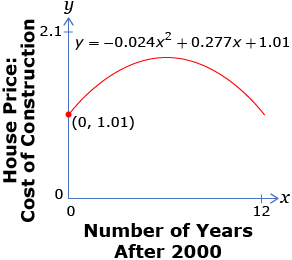Lesson 8
1. Lesson 8
1.9. Explore 5
Module 4: Quadratic Equations and Inequalities
Modelling Problems with Quadratic Inequalities
The phrase “carbon footprint” refers to the amount of greenhouse gases produced through such activities as manufacturing a product or constructing a house. A carbon-neutral home or a zero-carbon home is a home where the net amount of carbon emissions from energy consumption over one year is 0. Such homes may be outfitted with geothermal heating and cooling features, solar energy panels, water conservation properties, and carbon-neutral building materials. Such homes are said to have a carbon-neutral footprint.

© The Freestead Project. Used with permission.
Try This 5
Suppose the following graph shows the housing-price-to-construction-cost ratio of carbon-neutral homes for a Canadian city. The equation relates the housing-price-to-construction-cost ratio, y, of the number of years, x, since the year 2000. Here, 0 ≤ x ≤ 12.

- Between what years was the housing-price-to-construction-cost ratio less than 1.5? Write an inequality that models the problem.
- Solve the inequality. Explain the strategy you used.
- The solution to the inequality from question 2 should be in the form of an interval. Interpret this interval.
![]() Save your responses in your course folder.
Save your responses in your course folder.
Share 1
With a classmate, compare your answers to Try This 5. Discuss the following questions.
- What algebraic strategy or strategies may be appropriate to apply to this problem?
- How many different ways could you solve this problem graphically?
- How can this problem be modelled as a linear-quadratic system of equations?
![]() Save your responses in your course folder.
Save your responses in your course folder.